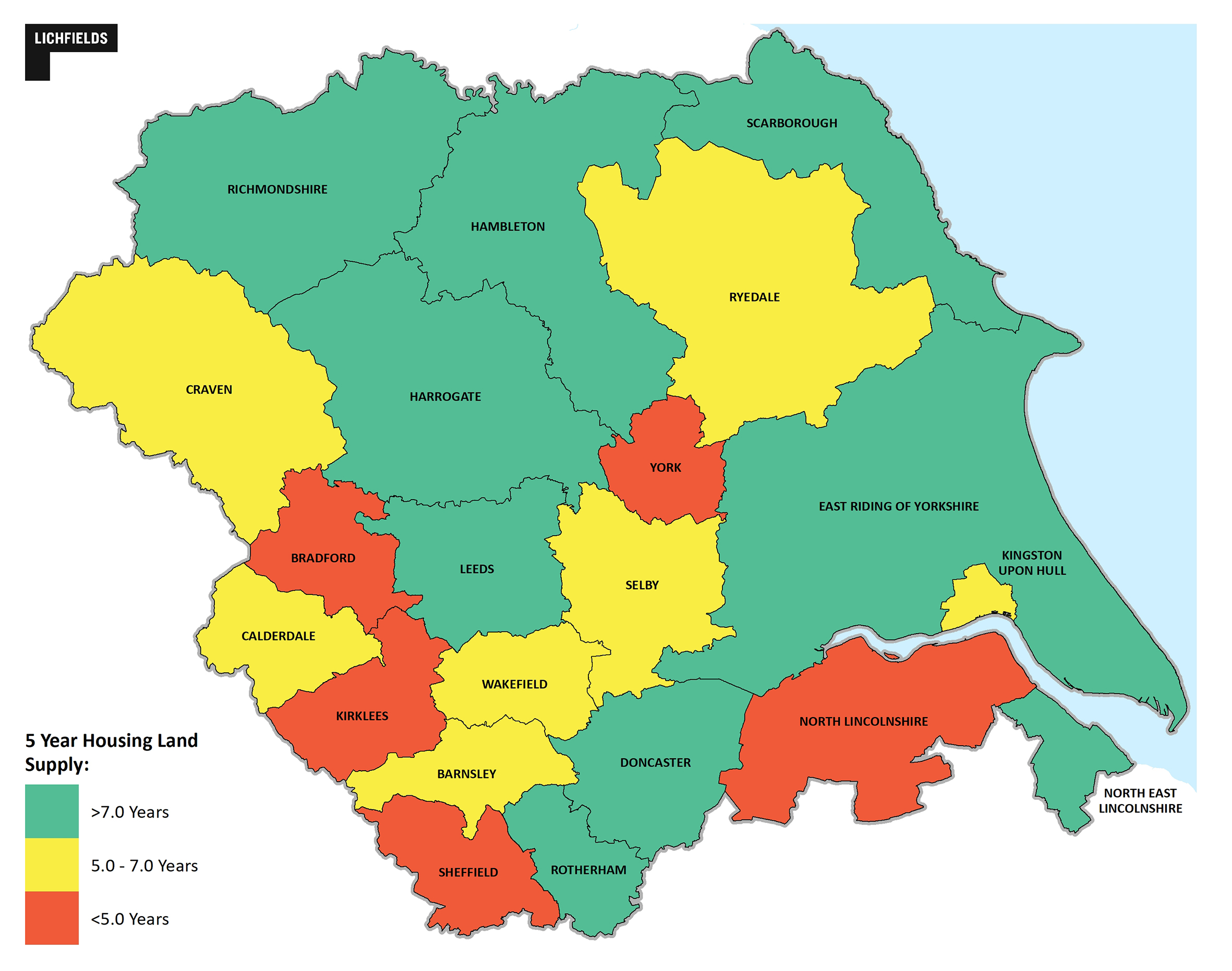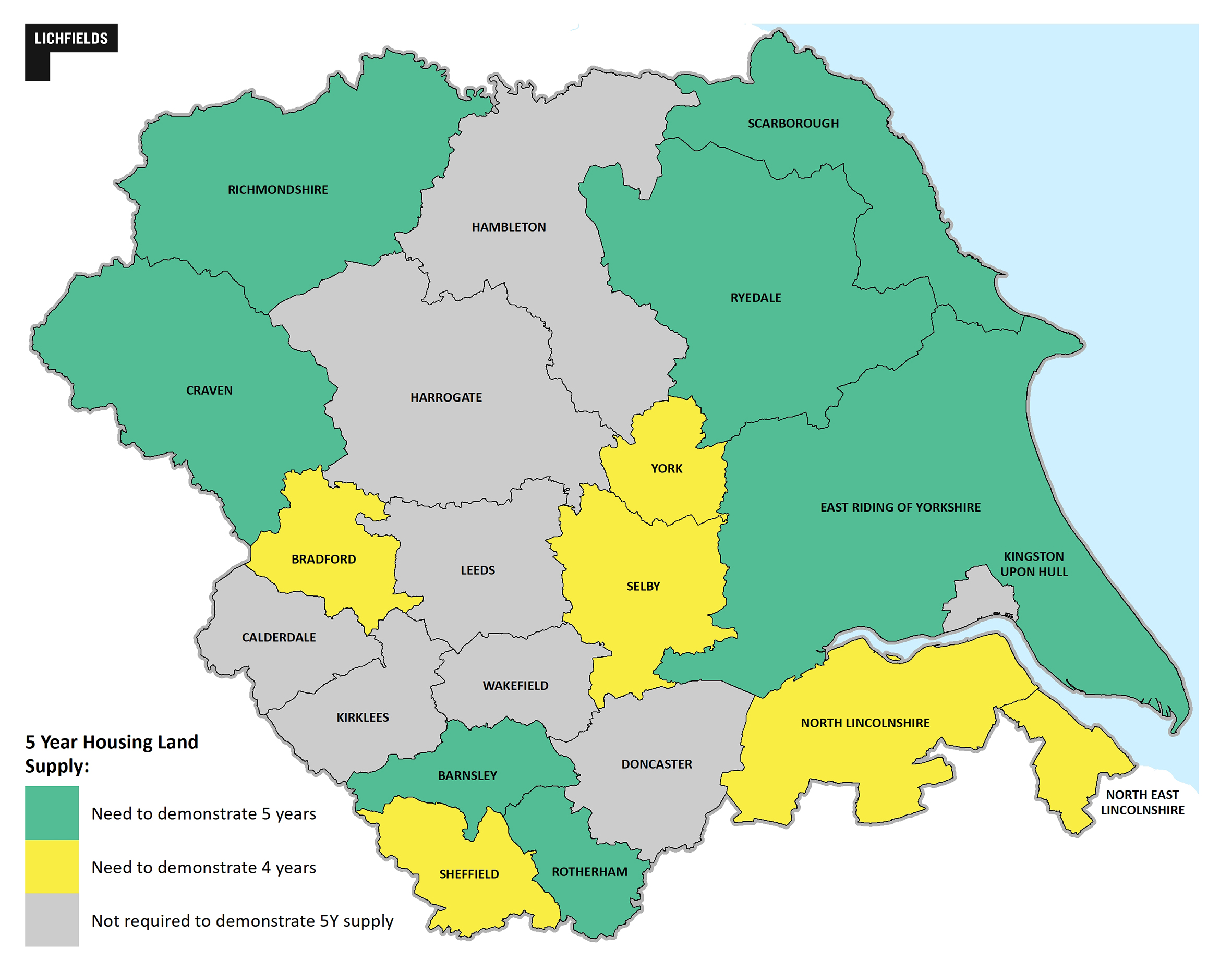The much anticipated changes to the National Planning Policy Framework (‘NPPF’) and related changes to the operation of ‘Five Year Land Supply’ (‘5YHLS’) and the ‘Housing Delivery Test’ (‘HDT’) were published at the end of December 2023. My colleague Harry Bennett wrote an excellent
blog related to this which summarised the key headline changes and what this means for how 5YHLS will now operate for local planning authorities (‘LPAs’) and the implications this is could potentially have on plan making and planning application decisions.
In summary, the changes are:
-
LPAs with a plan adopted in past 5 years (in most cases) don’t need to demonstrate a 5YHLS (some caveats apply to the determination of existing applications);
-
LPAs who have produced a draft plan that has reached Reg.18 or Reg.19 stage (and includes a policies map and proposed allocation towards meeting housing need) or with such plans submitted for examination only need to demonstrate a 4-year supply;
-
5% and 10% buffers are gone but 20% buffers remain (determined by the Housing Delivery Test);
-
Oversupply will count towards 5YHLS in the future but how this works is to be determined;
-
The eligibility criteria for Annual Position Statements is now wider; and
-
Paragraph 14 has been beefed up to protect areas with made neighbourhood plans.
The below flowchart sets out how 5YHLS now operates and more detailed analysis of the changes and potential implications are set out below.

This blog seeks to apply the new NPPF to LPAs in Yorkshire and Humber and identify those that:
-
Are now free of having to identify and update annually a 5YHLS (i.e. LPAs with an adopted plan that is less than five years old and that adopted plan identified at least a five year supply of specific, deliverable sites at the time the examination concluded (paragraph 76));
-
Now only need to demonstrate a 4YHLS i.e. LPAs that do not have an adopted local plan but have published or submitted for examination a regulation 18 or 19 plan that includes a policies map and proposed allocations towards meeting housing need (paragraph 226); and
-
Still need to meet the 5YHLS requirement i.e. LPAs that do not have an up to date local plan and have not published a regulation 18 or 19 local plan.
Prior to the changes to the NPPF, there were five local authorities that accepted that they could not demonstrate a 5YHLS including: Kirklees, Sheffield, the City of York, Bradford and North Lincolnshire. The situation in the later of these was particularly stark as their 5YHLS was below three years and in the case of Bradford was just 2 years. The plan below, demonstrates this, also highlighting those authorities, where (until the publication of the updated NPPF) their 5YHLS position has been marginal. Notable examples include Selby, Calderdale, Craven and Barnsley who’s stated position is marginal at 5.6 years or below.

Of course things have now moved on as a result of the changes brought about by the updated NPPF. The further plan below reflects the outcome of these changes, highlighting those authorities across Yorkshire and the Humber, that are currently free of having to demonstrate a 5YHLS; those that presently only need demonstrate a 4YHLS; and finally those where the requirement to demonstrate a 5YHLS remains.

In summary:
8 LPAs fall into category 1 (not presently required to demonstrate a 5YHLS) including: Doncaster, Hambleton, Harrogate, Leeds, Wakefield, Craven, Calderdale and Kirklees.
7 LPAs fall into category 2 (4YHLS), including: North East Lincolnshire, East Riding of Yorkshire, Selby, North Lincolnshire, Sheffield, City of York and Bradford.
6 LPAs fall into category 3 (5YHLS), including: Scarborough, Barnsley, Rotherham, Richmondshire, Kingston-upon-Hull and Ryedale.
There are some important points to note in each of the above categories:
In Kirklees for example, it will only benefit from the exemption of having to demonstrate a 5YHLS for a matter of weeks as its local plan will be more than 5 years old at the end of February 2024. After this time, it will not have a local plan adopted within the past 5 years and it will again need to demonstrate a 5YHLS, which it can’t (the 5HYLS is only 3.96 years).
In any event, the presumption in favour of sustainable development is presently triggered in Kirklees as a result of the outcome of the Housing Delivery Test
[1], so whilst this is the case, the position on 5YHLS is somewhat academic. The same is the case for Calderdale.
Barnsley was also an LPA that only benefited from the exemption for a matter of weeks as its Local Plan became more than 5 years old as of 3rd January 2024. Barnsley can, however, demonstrate a 5YHLS, albeit this is marginal with Barnsley’s last stated figure standing at just 5.6 years and is overdue an update.
-
For those LPAs that need to demonstrate a 4YHLS as part of the new transitional arrangements as set out in paragraph 226, York, Sheffield and Bradford will not be able to demonstrate this, whilst in North Lincolnshire, this will be marginal.
Selby will need to be closely monitored. There are several live applications and appeals being considered where the applicants have sought to demonstrate the absence of a 5YHLS. The updated NPPF shifts the goal posts for these schemes given that Selby now need to demonstrate a 4YHLS.
How a 4YHLS is to be calculated will be a key consideration here. At present, there is ongoing confusion in the industry on how the 4YHLS should be calculated. Reading the NPPF in isolation it would suggest that it is a four-year period test i.e. comparing the 4 year requirement against the 4 year supply, however, the insertion of paragraph 77 and 226 into the NPPF was likely intended to make it easier for a LPA to avoid having to demonstrate a 5YHLS and the possible tilted balance and in turn, to provide an incentive for LPAs publish a draft plan. This would only be realised if the 4YHLS was calculated over a 5 year period (i.e. a 4-year requirement assessed against a 5 year supply).
In Sheffield for example, the current 5YHLS is 2.87 years. If a 4 in 4 approach was used this would change the 5YHLS to 2.85 years, making the position very marginally worse. If, however, a 4 in 5 approach was used the 5YHLS would increase to 3 years. While this is still below the required 4 years it is helpful in showing the difference between the methods used and how the 4 in 5 approach is more aligned with the seeming intention behind the transitional arrangement.
The Government is expected to issue updated planning guidance to clarify the matter later this week.
Paragraph 77 of the NPPF states
“…The supply should be demonstrated against either the housing requirement set out in adopted strategic policies, or against the local housing need where the strategic policies are more than five years old…”
The accompanying footnote (42) states:
“Unless these strategic policies have been reviewed and found not to require updating. Where local housing need is used as the basis for assessing whether a five year supply of specific deliverable sites exists, it should be calculated using the standard method set out in national planning guidance.”
In Barnsley, the Local Plan became more than five years old on 3rd January 2024, however, a consideration for Barnsley will be whether their internal review of the adopted Local Plan (which was endorsed by the Council in November 2022) and its conclusions that the “Local plan remains fit for purpose and is adequately delivering its objectives” means that it should continue to utilise the housing requirement in the adopted Plan (despite in being more than 5 years old) as the basis for its 5YHLS calculations, or whether it should revert to the Standard Method derived figure. The latter is a much lower figure!
Had Barnsley concluded instead that the strategic policies in its Local Plan need to be reviewed, it would have needed to apply the Standard Method derived figure of 838 dwellings per annum and its 5YHLS position would have improved significantly.
The above situation will be the same for Kirklees at the end of February, albeit, Kirklees Council have accepted the need to undertake a Local Plan review so their figure will go from 1,730 dwellings per annum as set out in their Local Plan to the standard method derived figure of 1,567 dwellings per annum. This will make a more modest improvement to the 5YHLS position compared to what could have been the case for Barnsley.
Conclusion
Moving forward it will be interesting to see how the wider changes to the NPPF play out in plan-making and decision-taking, particularly in relation to the transitional arrangements introduced under paragraph 226.
It is hoped the amendments will incentivise and galvanise those local authorities currently in the midst of drafting local plans to make inroads and get a local plan progressed and adopted. This will also be significant for those local authorities whose exemption from having to demonstrate a 5YHLS ends this year when their local plans become more than five years old.
The government clarification on how the new 4YHLS should be calculated will also be significant for a number of local authorities in the Yorkshire and Humber area, in particular Selby.
[1] Paragraph 11 confirms that the ‘presumption in favour of sustainable development’ applies for decision making purposes where the policies which are most important for determining the application are out-of-date. Footnote 8 clarifies this as being where the Housing Delivery Test indicates that the delivery of housing was below 75% of the housing requirement over the previous three years.






